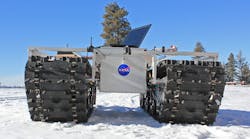While NASA’s Curiosity rover explores Mars, its cousin GROVER is about to embark on a mission much closer to home. From May 3 to June 8, it will roam the ice sheet of Greenland and measure the changes occurring there. The autonomous, solar-powered robot carries a ground-penetrating radar to study how snow accumulates and adds layers to the ice sheet (see the figure).
During the summer of 2012, temperatures that were higher than normal caused surface melting across about 97% of the ice sheet. GROVER will detect the layer of the ice sheet that formed as a result. Researchers compare annual accumulation to the volume of ice lost to the sea each year to calculate the ice sheet’s overall mass balance and its contribution to the rise in sea levels.
Snowmobiles, aircraft, and satellites normally are used for these measurements. NASA believes GROVER will cost less. The rover is six feet tall, including its solar panels, and weighs about 800 pounds. It uses two repurposed snowmobile tracks to get around. Cool Robot, a rover developed at Dartmouth College, will join GROVER on its mission and tow instrument packages.
GROVER is powered entirely by solar energy, so it can operate in pristine environments without adding to air pollution. The panels are mounted in an inverted V, so they can collect energy from the sun and from sunlight reflected off the ice sheet. And since the sun doesn’t dip below the horizon during this time of year on the ice sheet, GROVER will always have an energy source as it conducts its mission longer than any human could.
A ground-penetrating radar powered by two rechargeable rests on the back of the rover. The radar sends radio wave pulses into the ice sheet. The waves bounce off buried features, informing researchers about the characteristics of the snow and ice layers. GROVER will operate from the National Science Foundation’s Summit Camp, where the ice sheet is about 2 miles thick. It will explore the ice sheet at an average speed of 1.2 mph.
Researchers will keep GROVER within a 3-mile range of the camp when the tests begin and communicate with it via Wi-Fi. GROVER will transmit some data during its trial phase to demonstrate that it’s working properly, but the researchers will wait until the end of the season to recover most of the data. Later, the researchers will switch to satellite communications, enabling GROVER to roam farther and transmit data in real time. Eventually, researchers hope to drive the rover from their desks.
NASA
